
by Clay Farris Naff Thursday, January 5, 2012
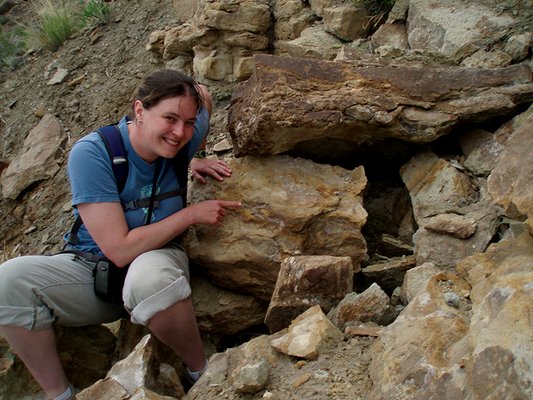
Emily points to the embedded dinosaur fossil she discovered in an outcrop of the Morrison Formation. Clay Farris Naff
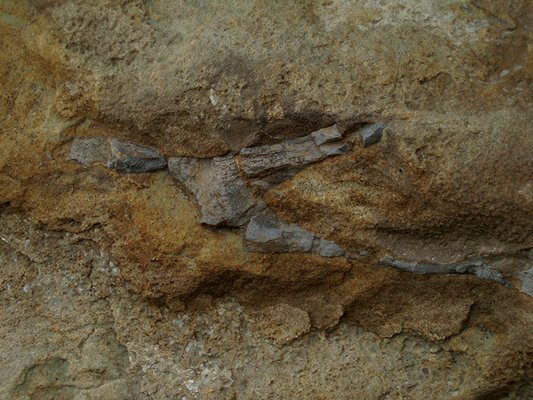
A closer look at Emily's fossil. Clay Farris Naff
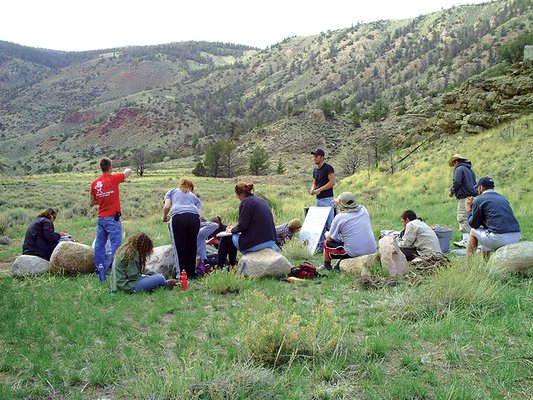
In David Harwood's field course for future teachers, students learn the basics of geology. Kyle Thompson
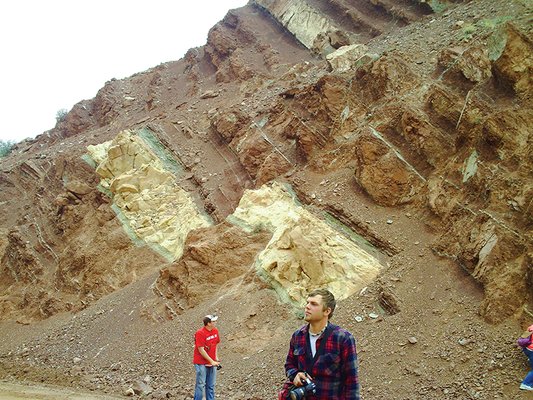
At a road cut, David (foreground) and Ben ponder the 'layer cakes' above them. Kyle Thompson
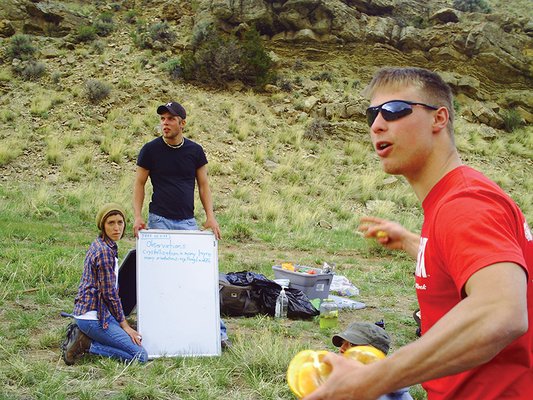
David (middle) leads the discussion that solves the Mystery Rock puzzle. Aaron (right) and Chelsea also help. Kyle Thompson
David Harwood’s geology field course for future teachers is not a network reality show — but it should be. The three-week course has all the humor, drama, exacting challenges and bleepable moments of “Survivor.” But in contrast to the staged setups of TV “reality” shows, Geology 160 offers billions of years’ worth of authentic geological history that students see, taste and scrape from under their fingernails.
Picture it: A dozen students from the University of Nebraska at Lincoln, plucked from their prairie classrooms and sent into the mountainous wilds of Wyoming with only the barest guidance, will attempt to replicate centuries of geological discoveries while Mother Nature and human nature test their endurance in every conceivable way. They will suffer torrential rains, flooded tents, illness and blistered feet. Coyotes will menace their campsite. Morning frost will numb their fingers as they try to strike damp matches. Jealousies and resentments will creep in among them. Even ideology will come into play, as religious and secular worldviews confront the massive geologic story written in rock.
The payoff — not riches or fame, but a hard-won command of the process of scientific inquiry — will make it all worthwhile. Yet even more is at stake: Beyond the education of this handful of students, the scientific literacy of future generations hangs in the balance.
Recent research at the University of Minnesota suggests that if science teachers don’t have confidence in the scientific narrative — if they fudge the age of Earth or introduce Creationism as an alternative to evolution — they create indelible doubts about science. The study, by Randy Moore and Sehoya Cotner, published in the journal BioScience in May 2009, indicates that at least one in four science teachers engages in such practices, contributing to a scientifically illiterate nation.
The public’s failure to embrace science is why Harwood, a micropaleontologist and marine geologist who holds the Stout Chair in Stratigraphy in the University of Nebraska’s Department of Geosciences, is willing to leave his wife and two small children behind and hit the road for several weeks of dawn-to-dusk discovery in the rugged outdoors.
“I wanted to teach a class that makes a difference,” he says. Harwood knows that opening the eyes of a dozen students won’t change the world. Still, he feels that by nurturing teachers with a firsthand appreciation of science, he can contribute to a quiet generational revolution. Harwood and his former doctoral student, Richard Levy, started the class in 2006 with alumni donations and a grant from the National Science Foundation. Now, they rely on private support, especially from the American Association of Petroleum Geologists Foundation and Marlys Christiansen, who endowed the class in honor of her late geologist husband, Richard (Chris) Christiansen.
Harwood’s own research — he leads the Antarctic ANDRILL project — has produced a robust history of millions of years’ worth of climate change and Antarctic ice sheet variation by drilling more than a thousand meters into McMurdo Sound. When he gives public presentations about the project, he finds that many Americans simply don’t know how to distinguish scientific evidence from political talking points. The problem, in his view, is not just the religious or political hostility to science that crops up in many segments of society, but the way that science itself is so often taught — as if it were an arcane revelation, full of impenetrable jargon and forgettable factoids. In this class, Harwood tells his students, “Geology is the vehicle. Inquiry is the goal.”
The learning objectives of Harwood’s field course match any beginning geology class: Students are expected to grasp that Earth’s history is recorded in rock and sediments. They learn to read the rocks using Steno’s principles of superposition, horizontal continuity and cross-cutting relationships, as well as the concepts of uniformitarianism, geologic time and plate tectonics, among other things. In this class, however, these concepts won’t take hold until after the students have observed, investigated and analyzed in the field. During a predeparture meeting, Harwood and his teaching assistants organize the class into teams of three, issue them hammers, rock boxes and maps, and go over main geologic ideas lecture-style. For most of the novice geologists, Harwood at this stage comes across like Charlie Brown’s teacher: wah-WAH, wah-WAH, wah-WAH.
The students themselves at first seem to fit the caricature roles of any reality TV show. “It’s GeoQuest! — starring Ben, the red-haired Joker; Tatiana, the brassy blonde; Aaron, the good-time geology major; Laura, the free-spirited ingénue; Chelsea, the Indian Princess; and Alison, the female jock. Also featuring David the Defiant One (who turns out to be a full-blown Young Earth Creationist) and Emily the Science Nerd (a former doctoral candidate in microbiology who long ago left religion behind).”
Of course, they are all more complex than that, but their inner selves will not emerge until they are out in the field. Following the lecture, they hit the road in three red vans to explore nearly two dozen geological sites. From that point on, Harwood switches from lecturer to something more like a Zen master. To aid in their discovery, he utters koans such as “You’ve got to think about what’s there, and also what was there but isn’t there.” Later, after they have gone through the hard work of systematic inquiry, he fills in the details.
At first, this inversion of the usual science pedagogy bewilders the students. “Oh my God,” shrieks Tatiana at one point, clutching her blond head between her hands. “I feel like I’m freakin’ five years old!”
Gradually, the students realize that seeing like a child, without the clutter of preconception, can be a critical first step in science. (It worked pretty well for Einstein.) It can also make science far more intriguing, convincing and rewarding.
A few days later, Tatiana is onboard. “I was really frustrated. We’re stomping around ... and I don’t even know what we’re supposed to be looking for. I’m like, ‘Just give me the answer!’ But now I see that it wasn’t about finding the answer, it was about the process of asking.”
Indeed, out here method trumps content. “We’re learning by discovery,” Harwood tells the students. “You’re reading the landscape and making inferences.”
Ben, who was planning to become a pharmacist before switching career paths to become a science teacher, catches on fast. Standing on a boulder-strewn hillside, caked in dirt as red as his hair, he shows me a handful of subsoil he has excavated. “Know what this is?” Ben grins. “I call it ‘green shaley stuff.’ We don’t know the names of anything! But that’s OK.”
He turns philosophical. “You can’t just accept what someone says — or even what you think. You have to try out different ideas.” Ben has just stumbled onto geologist T. C. Chamberlin’s precept of multiple working hypotheses, a key 19th century contribution to the modern scientific method.
Even those who previously disdained science come around. Five days into the expedition, Chelsea, a slim, chestnut-haired anthropology major, recalls that before finding an inquiry-based course, “I avoided science and math like the plague.”
With her Chickasaw ancestry and humanities background, she has been more attracted to Native American mysticism than traditional science courses. “It’s all presented to you as knowledge handed down from this professional class of scientists. So you feel like you just have to learn and regurgitate it.”
Marveling at Wyoming’s spectacular pine-studded peaks, she adds, “This
is totally different. I’m starting to feel like, ‘Hey, I can really do
this!’”
She is not alone. Each student’s inner scientist makes an appearance on
this journey. Not all will end up career teachers, but they will bring
their new way of seeing the world into the classroom at least once. On
their return to Nebraska, the teams will guest teach a science class at
a middle school in Lexington. There will be no lectures, however. Their
lesson plans center on discovery.
Before this remarkable transformation could occur, however, all of the students had to endure frustration, discomfort and melodrama. It began at daybreak on the students’ first morning on the road. They crawled out of their sleeping bags and discovered that one tent had been staked over a bunny nest. The mother rabbit stared at them balefully. As soon as they pulled up the tent, she hopped to her nest only to find that her young had suffocated in the night. It was so gruesome a spectacle that gallows humor broke out. The trio that entombed the baby rabbits became known as BBK: the Booyah Bunny Killers.
Humor could not dissipate all tensions. Even as the students discover fault lines in the earth, fractures grow among them. Alison, the crew athlete who towers over everyone, also exhibits a domineering persona. On her team, the (ahem) Pieces of Schist, she frequently clashes with geology major Aaron, who though a head shorter than Alison feels he should take the lead — or at least not be bossed around. Caught between these two strong personalities, Laura, a sweet-natured girl with rosy cheeks and long, corkscrew hair that floats as freely as her spirit, tries in vain to make peace. It is fortunate for her teammates that she came unarmed. Laura lets it be known that she bagged two deer over winter break and is presently working their hides.
Meanwhile, all is not well with another team, the Gravediggers, where a secular scientist fumes at being yoked to a yokel (as she sees it). Emily arrived with more science experience than any other student. As a microbiology doctoral candidate, she had put in several years in a virology lab. She expected to be a star on this trip, but she gets bogged down like a pioneer in a muddy rut. “I’m an explorer,” she declares, yet the lack of explicit directions clearly bothers her. Where’s the map? What’s the objective? It’s all quite annoying. And then there’s her partner. “David is being a jerk, basically,” she says. He keeps going off on his own, or arguing that Earth is less than 20,000 years old. Worse yet, as she complains, others are shying away from her.
In a candid moment, she admits, “I have acceptance issues.” Small
wonder. At the age of nine, she lost her father to Lou Gehrig’s Disease.
She lost her religion shortly thereafter. Ever since, she has struggled
to feel at home in the world. And now, those struggles are surfacing.
But then something wonderful happens.
The entire class is scouring a steep outcrop of the Morrison Formation near Cottonwood Creek, not far from the Alcova Reservoir. The rock layer is a conglomerate of sandstone, siltstone, mudstone and limestone deposited between 155 million and 146 million years ago and is known for harboring many dinosaur fossils. However, Allan Fraser, a retired physicist turned amateur geologist who accompanies the group on this hike, tells them that the site has been “picked clean” since the fossilized skeleton of a Camarasaurus was discovered here in 1991. Emily proves him wrong. Perched on a vertical face, she leans out to examine a desk-sized chunk of rock that has broken off and discovers a dinosaur fossil. Fraser confirms her find. For Emily, it is a moment of pure joy. In her field journal, she writes, “I discovered that I am quite the fossil hunter. I love it!”
The moment passes, however, and before long she and the entire class are mired in perplexity again. If you’re looking for a challenging geology site, Wyoming can’t be beat. On the trip, the students encounter a river that abruptly plunges into a mountain only to resurface a quarter mile away, rocks that look like giant Easter eggs, muddy road cuts that appear to contain giant pieces of layer cake, and naked mountains that jut like crocodile teeth.
As the celebrated nature writer John McPhee notes in his book “Rising from the Plains,” Wyoming’s mountains “are the least explainable in the world.”
It’s a book Harwood has his students read, but it provides only comic relief as they try to comprehend a landscape written in a language as remote to them as Urdu. Ben the Joker conceives of McPhee as a top-hatted, monocle-wearing snob, and soon the campsite echoes with arch accents. “Why, it’s colluvium, of kawse.”
Then comes a breakthrough. The students stand in a broad glacial valley, facing an anomaly that has stumped them. Nicknamed “Mystery Rock,” the wavy, multilayered outcrop seems a rummage sale of Wyoming’s geological jigsaw puzzle.
Remarkably, it’s David, the avowed Creationist, who leads the charge to solve it. That morning, he first showed signs of a thaw. Facing resistance from Emily on a future lesson plan to have students create model fossils when they get back to Nebraska, he urges her to let them take their models home over the weekend to dry out. “They need to understand that there has to be time for fossils to form. A lot of time.”
This from a guy who has steadfastly refused to put a single date down in his journal for fear of committing blasphemy. Until now, David has always struck a defiant pose. When the group squats in the grass at a campsite to listen to Harwood, he stands. If most students are chipping away at the base of an outcrop, David will be found at its summit. When they go hither, he goes yonder.
Now he tells Emily, “We just need to trust the inquiry process.” Quite a change for someone who had earlier declared, “I’m just taking this course for giggles and credits.”
At Mystery Rock, David proves to be an able leader. As the class hunkers down in the glacial valley to compare observations, he encourages them to synthesize their observations. He calls for evidence of how wind or water might have carved the outcrop. He even tosses out multiple hypotheses for the group to consider. “Did it rise from below? Was it here before the glacier, or did it come down after?”
After two hours of intense discussion (and an opportunity to ask 20 yes-or-no questions of the professor and teaching assistants), they get it. Mystery solved! Mystery Rock is a bit of the Gallatin Limestone. The Gallatin Limestone is a mixture of calcareous sand, shale and pebble-sized conglomerate that formed during the Late Cambrian and Early Ordovician periods some 490 million years ago. During deposition, repeated storm surges rode up the inland sea that once covered western North America, ripping up layers of the deposited beds and reconsolidating them into a new chaotic sedimentary layer — the formation’s present, puzzling state. This proves a pivotal experience for the entire group. In the days that follow, everyone affirms that inquiry is the way to go.
“It’s not about content that you memorize and get tested on,” Ben exults. “It’s about discovering knowledge!”
That impression strengthens when Harwood reveals that he had disclosed virtually all the answers they were seeking in the lecture he gave before they set out. None recalls anything they heard. David notes in his field journal: “It was nice to get information regarding each layer. However, I don’t remember the information, because it was given to me. This is very supportive of the inquiry process.”
The students believe the knowledge they gain through inquiry will prove more memorable. Furthermore, most feel that it will be more supportive of the old-Earth, evolutionary process at the core of standard science. Gazing at the Grand Tetons, Alison says, “This is stone-cold fact. You can’t look at this and deny that it’s millions of years old.”
Ben says that when he’s a teacher he will introduce inquiry methods into his class. If students raise religious objections to the scientific account, he plans to tell them: “It’s fine to believe in religion, but that’s not science. Even if you don’t believe it, this is what science is. While we’re in that context, how do you think this could have formed?”
As for David, it would be unreasonable to expect him to break with his Young Earth scriptural beliefs as the result of a few weeks in the field, and indeed when the class ends he declares himself as orthodox as when he signed on. Yet, his outlook has changed. He acknowledges that a broad spectrum of views about science exists among people of faith. He has let himself try out the role of a scientist in the field, and somewhat to his surprise, he finds, “I really enjoyed it.”
David plans to become a journalist rather than a teacher. But for those who are headed for the classroom, it appears that this “reality show” has given them a prize they may not have expected: a strong confidence in the reality of science. As Tatiana remarks, “If I had to choose between faith and science at this point, I’d go with science.”
© 2008-2021. All rights reserved. Any copying, redistribution or retransmission of any of the contents of this service without the expressed written permission of the American Geosciences Institute is expressly prohibited. Click here for all copyright requests.